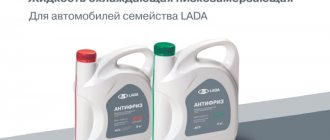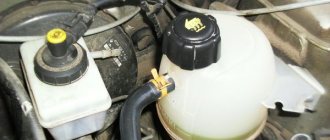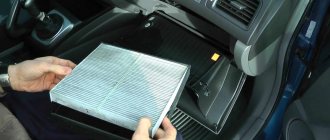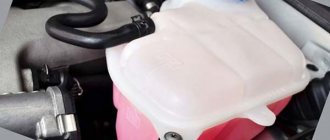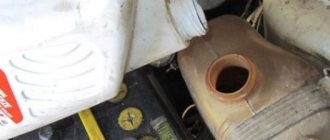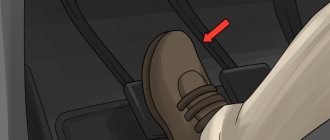There comes a time in the life of a car enthusiast when he begins to worry about the question of what kind of antifreeze is in his car? In this case, we will consider antifreeze for the VAZ Lada Vesta. Sintec antifreeze lux G12, a familiar name for a VAZ owner. This antifreeze is poured into the Lada Vesta from the factory. Let us immediately note that antifreeze for Lada Vesta is of the popular G12 class (TU 2422-047-51140047). This is a positive point, since the cooling system only benefits from this. The coolant that is poured at the factory has an additive package that effectively resists corrosion and greatly extends the service life of the cooling system as a whole. According to the book, it is necessary to change the coolant of the Lada Vesta cooling system every 90,000 km. mileage, or no later than 5 years of driving. There is no need to be afraid of the issue of replacing antifreeze - the service life is decent. Its color is red-orange. It does not contain silicates. The base is ethylene glycol and carboxylate substances. Although there is a downside to this antifreeze, it begins to act only when a source of corrosion has already appeared. Although this feature prevents the appearance of a layer that protects the system from the inside. This prevents the layer from shedding as a result of operation. Result: increased service life, improved heat transfer. Read the article to the end and get many answers on the topic of coolant.
When to change antifreeze
After 90,000 km, or after 5 years, when the time comes to change the fluid, you will not need any special knowledge or tools, because the matter is not too complicated. On the Lada Vesta everything is done quite simply. Therefore, you can safely change it yourself. An independent replacement for a Lada Vesta can be done both on an overpass and in a garage pit. If you are smart, you can climb with a jack and stands under the car. Everyone's conditions and opportunities are different. But in this case, do not forget about safety precautions!
Coolant fluid for Lada Vesta
Vesta can only be filled with antifreeze that is recommended by the manufacturer. If one of the listed requirements is not met, consequences may arise: unstable engine operation, boiling of liquid, leaking rubber tubes, and the formation of deposits on internal surfaces.
High-quality cooling of the car engine ensures its stable operation in any mode without breakdowns. Therefore, you need to know what kind of antifreeze is poured into Vesta at the factory, the replacement interval, and compatibility with other compounds.
How the Vesta engine is cooled
Each owner must monitor the condition of the cooling system (CO) and carry out timely maintenance to prevent overheating of the power unit. Lada Vesta uses a closed liquid system with forced circulation of working fluid. Principle of operation:
- When the engine is running, the cooling jacket heats up. If the temperature rises to a level in the range from +85°C to +89°C, the thermostat opens and fluid circulates in the system in a small circle past the engine radiator.
- The heated liquid circulates through the tubes, cools to a certain temperature, and then flows through the system again into the engine jacket.
- When the temperature reaches +102°C, the thermostat fully opens the valve and the OS begins to work with maximum efficiency.
- The heated liquid from the cooling jacket is directed to the interior heating radiator.
- In case of critical overheating, excess fluid enters the expansion tank, and an emergency sensor is activated, signaling the driver about overheating.
Photo source: https://www.zr.ru/content/articles/852383-lada-vesta-instrukciya-po-zamene-oxlazhdayushhej-zhidkosti/2581/
On power units from AvtoVAZ with a volume of 1.6 or 1.8 liters, the pump is brought into operation via a timing belt drive.
In the cold season, an electric heater is used to facilitate engine starting. It also serves for partial heating of antifreeze and stable operation of CO.
Antifreeze requirements
Antifreeze is used to remove heat from the power unit. Car manufacturers specifically select chemical compositions that are effective for cooling and also safe for use. That is why you need to follow all the requirements for selecting an antifreeze.
The Lada Vesta coolant should:
- effectively remove heat from the power unit;
- do not form deposits on the inner walls of pipes, pumps, radiators, jackets, which impair fluid circulation and reduce cooling efficiency;
- maintain properties under specific temperature operating conditions;
- do not act aggressively on the system materials;
- do not soften rubber tubes and oxidize metal;
- do not form foam inside the communications when the engine is running;
- do not reduce the efficiency of heat removal from heated parts.
What kind of antifreeze is poured at the Vesta plant
Lada Vesta is filled with carboxylate Antifreeze Lux G12 produced by Sintec in CO. The composition is based on a solution of glycol and organic additives.
Photo source: https://www.drive2.ru/l/538752177468868257/
Its main advantage is the absence of elements that form insoluble deposits on the internal walls of the cooling circuits. Many reviews from car owners confirm the high effectiveness of antifreeze.
Why is the level of antifreeze in Lada Vesta decreasing?
Increased antifreeze consumption occurs for a number of reasons:
- leaks in the circuit, pipes, radiator, pump, heater, valve;
- overheating, as a result of which the plug may rip off the filler neck of the expansion tank;
- water pump o-ring wear;
- The cylinder head gasket is leaking or the bolts are not tightened enough;
- The water jacket plugs are not tightly closed.
Coolant replacement
Antifreeze on Vesta needs to be replaced periodically, since it loses its properties over time, and insoluble particles may appear in it from the internal surfaces. Waste fluid increases wear on the pump's sliding bearing, which often leads to its failure. This is especially true for the engine jacket, inside of which it is technically difficult to remove scale.
Photo source: https://www.zr.ru/content/articles/852383-lada-vesta-instrukciya-po-zamene-oxlazhdayushhej-zhidkosti/2581/
When replacing coolant, it is important to use the recommended brand, observe replacement periods, and ensure compliance with technical operating conditions. Prices should not be taken into account, since even the most expensive composition will be cheaper than even minor CO repairs.
When is it time to change antifreeze?
You need to change antifreeze in a Lada Vesta or Cross after a mileage of 90 thousand km or 60 months of operation since the last replacement. The condition that occurred first is selected.
Which antifreeze to choose for Lada Vesta
What antifreeze should I put in Vesta? AvtoVAZ allows the use of liquids only of class G12. In addition to antifreeze produced by Sintec, a number of analogues can be used:
- Cool Steam Premium or Standard;
- Felix Carbox;
- G-Energy Antefreexe;
- TC-Felix.
Photo source: https://www.zr.ru/content/articles/852383-lada-vesta-instrukciya-po-zamene-oxlazhdayushhej-zhidkosti/2581/
Original fluids from the Lada car manufacturer are suitable; their properties and color (yellow-pink) are the same as those produced by Sintec. Other compounds that have a quality certificate from AvtoVAZ are also permitted.
Is it possible to mix different coolants?
The development of antifreeze by manufacturers takes into account the technical characteristics, functional features of the lines used, pumps, radiators and other components. Their chemical compositions differ, so mixing may result in the formation of compounds whose effect on the cooling circuit is unknown.
It is difficult to predict the consequences of mixing several types of compounds in advance, even if the following conditions are met:
- matching liquid color;
- one manufacturer;
- one brand;
- identical characteristics of the compositions.
Photo source: https://www.zr.ru/content/articles/852383-lada-vesta-instrukciya-po-zamene-oxlazhdayushhej-zhidkosti/2581/
Mixing is likely to cause serious damage to the CO, requiring costly repairs. Also, these actions will void the warranty on the car. Therefore, mixing antifreeze is strictly prohibited.
How to drain coolant from Vesta
Drain antifreeze or any other antifreeze in the following order:
- Drive the car onto the overpass.
- Wait until the engine cools down.
- Remove the protective plate from the power unit.
- Unscrew the 3 bolts securing the starter to the clutch housing and remove it. Access the drain screw.
- Place a 10 liter container under the radiator.
- Use a clamp to release the hose clamp (for a compression type) or unscrew a screwdriver (for a threaded type) on the radiator outlet to drain so that the liquid flows into a container.
- Unscrew the plug located on the cylinder block.
- Unscrew the expansion tank cap and increase the drain speed.
- After completing the procedure, install the parts in place.
How much antifreeze to pour into Vesta
The amount of coolant poured into the Lada Vesta at the factory is 7.84 liters. Therefore, for a complete replacement you need at least 8 liters. You will have to buy a canister of antifreeze, the volume of which is 10 liters, so that the remaining 2 liters can be used for topping up if the level drops.
Fill in antifreeze only when the engine is cool and not running, provided the system is sealed. The level should be maintained in the middle between two marks: minimum and maximum. When heated, the liquid expands and can therefore exceed the maximum level.
Safety precautions when working with antifreeze
Antifreezes have a complex chemical composition and therefore pose a threat to human health. It is necessary to prevent them from entering the mouth and stomach. If they accidentally got there, then mandatory gastric lavage and an urgent call for an ambulance are required. In case of contact with exposed skin or mucous membranes, abundant rinsing with water is required.
It is also recommended to follow a number of safety rules:
- store the liquid in an airtight container designed for this purpose;
- do not allow liquid to come into contact with open areas of the body, food, or personal hygiene products;
- do not allow coolant to come into contact with gasoline or oils;
- pour new antifreeze into the system, leaving an available volume of at least 10% of the total volume or according to the marks applied by the manufacturer.
How to drain antifreeze from Lada Vesta
It is preferable to change the fluid when the car has cooled down. Therefore, if the car engine is still hot, do not rush. Wait until it cools down, as it is very easy to get burned and injure yourself. It is very dangerous! Therefore, performing it on a cold car should not be taken as advice, but as a rule. After all, you can get burned by antifreeze and hot car parts.
- Before replacement and when the car has cooled down, it is necessary to unscrew the cap of the expansion tank. This will relieve excess pressure in the cooling system.
- If your vehicle has an engine guard installed, it must be removed to get to the drain holes. The standard engine protection is secured with thirteen bolts. They are unscrewed with a 10 socket.
- On the left side of the radiator there is a pipe; under it we place a container into which we will drain the coolant. It is better to worry in advance and choose a vessel of optimal size and elastic material. Before carrying out work, it is advisable to minimally clutter the area around you. The container with the drained liquid must be moved and lifted, and therefore it is better to work with durable (rigid) containers. To prevent antifreeze from pouring out at full force, you can screw the cap on the tank. Those who do not experience discomfort can leave the lid open. This will speed up the process.
- Next we need pliers. Loosen the clamp on the pipe and pull it to the side so that you can remove the hose without any obstacles and with ease. We remove the hose, and the liquid successfully drains into the container. If the cap on the tank was screwed on before draining, then when the bulk has drained, you need to remove the cap from the expansion tank back so that the liquid is completely drained. After this, we put the hose on the pipe and install the clamp.
- The next step is draining the antifreeze from the cylinder block. For this step it is necessary to remove the starter. If this is not done, antifreeze will flood it. Before working on electrical parts in a car, be sure to remove the terminal from the battery. Next, using a 10mm wrench, unscrew the three bolts that secure the starter to the clutch housing. We secure the starter using the wire tying method and move it to the side so that it does not interfere with us.
- We unscrew the plug that is located on the cylinder block. A key size 13 is required. This will drain the liquid from the car system as much as possible.
- Screw the plug into place. The landing point has a conical thread, so we don’t need to buy any additional gaskets or rings. The tightening torque according to the ABC book is 25-30 Nm.
Risks when filling with low-quality coolant
If you don’t know what kind of antifreeze is in your car, then mixing different types of technical fluid can lead to negative consequences, since additives of different classes react unpredictably with each other. The most dangerous negative point is the loss of anti-corrosion properties. The following problems may also occur:
- corrosion of the cooling jacket channels and leakage of coolant into the combustion chambers of the engine cylinders;
- softening of gaskets and leakage of antifreeze through leaks in the pipes;
- sedimentation, which impairs heat transfer;
- formation of rust spots;
- engine overheating;
- clogging and jamming of the thermostat;
- reduction of water pump life;
- clogging of the interior heater radiator honeycomb, etc.
With ineffective heat removal, the parts of the power unit wear out and become deformed. Also, overheating of the engine causes the pistons to jam. Malfunctions arising from low-quality coolant lead to expensive repairs of the power unit.
Where to fill
The plug has been tightened, now we fill it into the system until the expansion tank is full. I recommend pouring in a thin stream to avoid air lock. Don't forget about the starter, put it in place. We filled the system with antifreeze, put the terminal in place, and started the car. While the power unit is operating, we begin to compress all the hoses several times. This approach will ensure good filling of the system and air outlet. We monitor the fluid level, as it may gradually drop. It all depends on the uniform filling of the system when filling liquid and the release of air. Fill to the set level. Do not forget to tighten the plug. Initially, with a cold engine, the lower pipe will be cold for the first minutes after starting, but as the engine warms up, it will begin to warm up and become hot - this means that the system is fully operational, the liquid flows in a large circle - the thermostat has opened. We are waiting for the fan to turn on. Then we checked all the pipes again to make sure they were hot. It’s better to make sure once again that the entire system is full and there are no plugs. We turn off the engine.
When the engine has cooled down, check the fluid level once and, if necessary, add to the required level. That's all, the cooling system has been successfully serviced.
Coolant characteristics
For normal operation of the cooling system, a special non-freezing technical liquid is poured into the circuit. Antifreeze is made from purified water and an alcohol solution (ethylene glycol). Thanks to alcohol, the coolant does not lose fluidity at sub-zero temperatures. The density of the composition and resistance at low temperatures depend on the concentration and ratio of water and alcohol. In addition to frost resistance, the coolant must meet the following requirements:
- have a high boiling point (more than 100 °C);
- do not foam during circulation in the engine cooling jacket and pipes;
- do not cause corrosion of metal parts;
- prevent the formation of sediment and plaque on contacted internal surfaces;
- maintain the elasticity of rubber parts;
- have a neutral effect on parts made of non-ferrous metal;
- be environmentally friendly and safe for people.
In order for antifreeze to meet the listed requirements, special additives are added to the composition, making the liquid high-tech. To flush the system during circulation, active substances (surfactants) are also added to the composition. The color of the coolant does not affect performance. Dyes are added to distinguish antifreeze from different brands.
How to change the oil in a manual transmission
When changing the oil in a Lada Vesta with your own hands in the manual gearbox, first warm up the engine and place the car on a flat horizontal surface above the inspection hole.
- Disconnect the battery by disconnecting the negative terminal.
- Remove equipment that interferes with access to the filler hole.
- Remove the control plug.
- Now you need to crawl under the car and remove the engine cover. Afterwards, rip off the plug of the hole through which the used lubricant is drained, so that later it will be easier to unscrew the plug manually.
- Next, place an empty container for the waste liquid.
- Remove the drain cap in the crankcase.
- When the waste has completely flowed out, wipe the plug with a rag and screw it into place.
- Through a sleeve with a funnel or a special syringe, fresh material is pumped into the control hole until the oil begins to flow out of the neck.
- Close the holes and check their tightness.
READ How to change the battery in a Volkswagen Passat key
If the brand of oil is changed, the box is washed with a special inexpensive mineral washing material with detergent additives. The liquid is poured into an empty box after removing the old lubricant, the engine is allowed to run for 20 minutes at idle speed, then drained.
avtoexperts.ru
Answers (3)
According to the regulations, the coolant in Vesta must be changed every 90,000 km or after 3 years, whichever comes first.
In fact, I would increase the period of 3 years, and would say that it can be changed later, and if necessary, simply add antifreeze of the same color.
The manufacturer does not give precise recommendations on which one to fill. However, we can say that Felix Carbox G12 antifreeze is very often used for Lada cars.
The volume in the system is 7-8 liters of liquid.
PS few Vesta owners have yet driven enough to change the coolant. about choosing antifreeze - https://avtoexperts.ru/article/vibor-antifriza-ohlazhdayushhej-zhidkosti/ Do-it-yourself replacement - https://avtoexperts.ru/article/kak-zamenit-antifriz-podrobnaya-instruktsiya/
I'm taking a Lada Vesta 2015. The mileage is 60,000. So I’m thinking, should I change the antifreeze or not? It’s just that, on the one hand, it’s still early, but on the other, well, this is a domestic car. If you still need to replace the cooler, then consult the manufacturer and type.
Just pour one color into it. For a Zhiguli it’s just right, and then you’ll float it
Such savings will only backfire. You can't pour color at all! All sorts of collective farmers have come up with the idea that the properties of antifreeze somehow depend on color and now they are bringing this to the masses. REMEMBER! Antifreezes are generally colorless initially, and the color in them is created by a dye and solely for marketing purposes. When choosing an antifreeze, you need to look ONLY at the approval! Now, if you see the antifreeze approved by the car manufacturer, then you can pour it. The factory pours coolstream nrc in harmony, so take it. In general, antifreeze is excellent and will last for many years, but when purchasing it is always better to replace it - this is the right thing to do. I myself have one that’s flooded and I’ve been driving it quietly for 4 years now.
How to change the oil in a manual transmission
When changing the oil in a Lada Vesta with your own hands in the manual gearbox, first warm up the engine and place the car on a flat horizontal surface above the inspection hole.
- Disconnect the battery by disconnecting the negative terminal.
- Remove equipment that interferes with access to the filler hole.
- Remove the control plug.
- Now you need to crawl under the car and remove the engine cover. Afterwards, rip off the plug of the hole through which the used lubricant is drained, so that later it will be easier to unscrew the plug manually.
- Next, place an empty container for the waste liquid.
- Remove the drain cap in the crankcase.
- When the waste has completely flowed out, wipe the plug with a rag and screw it into place.
- Through a sleeve with a funnel or a special syringe, fresh material is pumped into the control hole until the oil begins to flow out of the neck.
- Close the holes and check their tightness.
READ Replacing intermediate bearing Ford Focus 2
If the brand of oil is changed, the box is washed with a special inexpensive mineral washing material with detergent additives. The liquid is poured into an empty box after removing the old lubricant, the engine is allowed to run for 20 minutes at idle speed, then drained.
